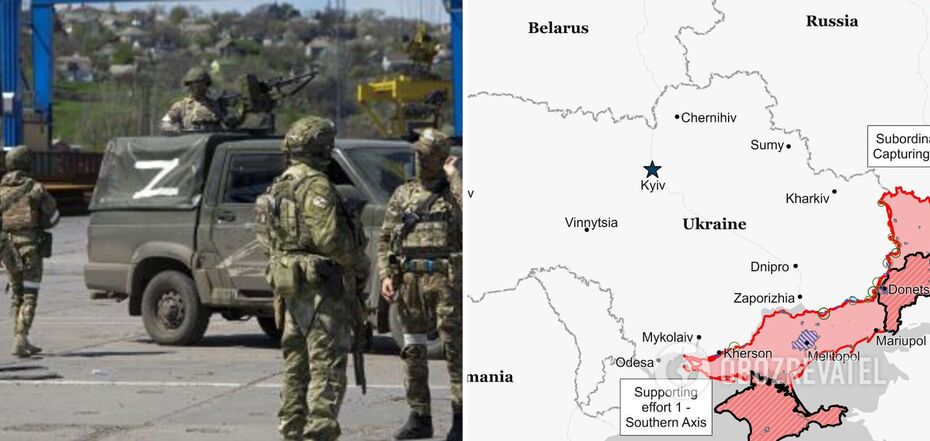War in Ukraine
Russia is forming a reserve capable of maintaining the pace of offensive operations in Ukraine: ISW assesses aggressor's plans
The Russian military command is building up reserves to support offensive operations in Ukraine. These reserves are unlikely to serve as large-scale formations to break through the frontline; rather, they are intended to allow Russian troops to replenish losses without a significant operational pause between localized offensives in the spring and the expected offensive efforts of the Russian army in the summer of 2024.
This is stated in a report by the American Institute for the Study of War (ISW) on March 21. According to analysts, Ukrainian military observer Kostyantyn Mashovets said the day before that the Russian military command plans to put into action most of its "strategic reserves" before a possible offensive in the summer of 2024.
Mashovets believes that due to a lack of equipment and manpower, these reserves are unlikely to be equipped and fully manned by then.
He cited Russia's 44th Army Corps, a unit that Russia is forming as part of the Leningrad Military District, and the 163rd Armored Repair Plant in Krasnodar Krai as examples of how limited materiel will hinder the formation of Russia's "strategic reserves."
Mashovets said that by the end of 2024, the Russian military command will likely be able to provide only 55% to 60% of the weapons and equipment that the 44th AK will need.
Mashovets also said that the Russian authorities are trying to double the production of the 163rd Armored Repair Plant, but this attempt is not likely to be completed even by the end of 2024 (it was planned for summer 2024).
According to the military observer, Russia's ability to produce new weapons and equipment, as well as modernize old systems, is "not in line" with how quickly it hopes to replenish its strategic reserves.
"Mashovets's assessment is consistent with ISW's assessment that Russian defense production is capable of sustaining the current pace of Russian offensive operations, but is unlikely to fully support a potential operational or strategic level mission in 2024," the Institute for the Study of War report said.
The ISW added that large-scale Russian manpower losses are likely to be greater than armor losses at this stage of the war, "especially because Russian forces have adjusted their tactics and shifted to ground attacks using heavy infantry to preserve armor at the expense of heavy manpower losses in the fall of 2023."
The Deputy Chief of the Defence Intelligence of Ukraine, Major General Vadym Skibitskyi, has previously reported that Russia is capable of generating forces at a rate equal to Russia's monthly personnel losses (approximately 25,000 to 30,000 people per month) and that Russia will have to conduct "mobilization" (probably large-scale) to create a "powerful strategic reserve".
The British International Institute for Strategic Studies (IISS) think tank reported on February 12 that Russia is likely to be able to maintain the current rate of equipment losses (more than 3,000 armored combat vehicles annually and almost 8,000 since February 2022) for at least two to three years, mainly due to the "reactivation" of old vehicles from warehouses.
It is unclear what kind of "strategic reserve" Russia is forming based on open-source reports, but Russia's known human and material limitations suggest that Moscow will likely not use these "strategic reserves" as a cohesive force to fight in Ukraine, but instead use them as a reserve of manpower to replenish losses on the front line, ISW believes.
The report states that Russia's "powerful strategic reserves" could theoretically serve as a first-echelon, breakthrough, or second-echelon force capable of conducting large-scale mechanized attacks on Ukrainian defensive lines and achieving significant operational success if they are fully equipped and properly trained.
"However, ISW predicts that Russia will not create a strategic reserve that could perform such functions due to the limitations described above," the Institute for the Study of War said.
According to analysts, Russia's efforts at cryptomobilization (mass recruitment into the Russian army without declaring a general mobilization) have proven to be able to sustain the current offensive in Ukraine despite heavy losses and may allow it to build up the strength to form more limited Russian operational reserves.
"The formation of additional reserves will likely allow the Russian military to replenish losses in Ukraine without making a significant operational pause between Russia's ongoing localized offensive efforts this spring and Russia's expected offensive efforts in the summer of 2024," the report says.
As reported by OBOZ.UA, the Ukrainian government has developed a plan for the Ukraine Facility, the implementation of which will allow to receive tens of billions of euros in funding from the EU. Its forecasts and estimates are based on the assumption that the active phase of the war will end in 2024.
Only verified information is available on the OBOZ.UA Telegram channel and Viber. Do not fall for fakes!




























